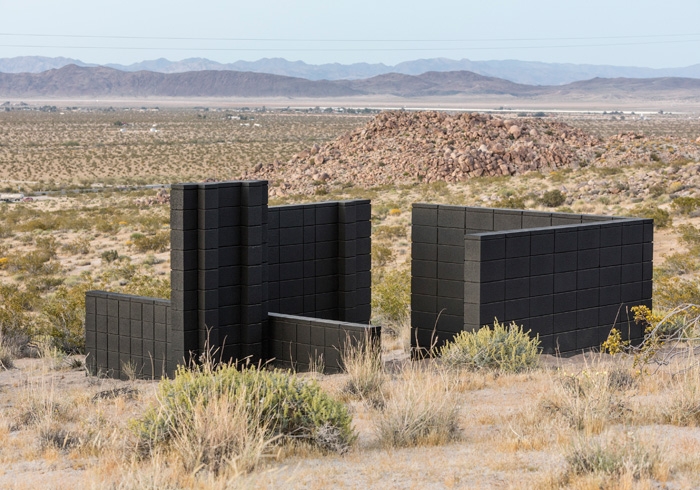Regen Projects, Los Angeles, and A-Z West, Joshua Tree, 8 June – 12 August
It’s 40 degrees. A dry heat. A light wind rustles through the sagebrush. My dog – a city slicker – pants desperately as we walk through a desert field, ambling about Andrea Zittel’s new permanent installation of her Planar Pavilions series (2017). The works are installed on Zittel’s property at A-Z West – her studio, residency and life-project in the California high-desert next to Joshua Tree National Park. Against the landscape’s harsh elements, the Planar Pavilions, black cinderblock constructs, stand silent and still. While evoking a macho minimalist language, Zittel’s oeuvre is staunchly dedicated to a more human-centric space. Though the artist longs for isolation, her work often implies a communal use. (‘To live Alone or Together?’ the artist pondered in her 2013 series How to Live Billboards.)
Her Planar Pavilions are skeletal suggestions – or ruins – of interior spaces meant to be shared: living rooms, bedrooms, places where friends might join for a meal, or a nook where one might read the paper in the early morning light. Highly considered and articulated spaces abound across the artist’s multiacre property (elsewhere, shipping-container-cum-apartment-units use minimal materials to articulate the essentials: bed, desk, storage area). Basking in the dry heat, and sited among similar structures (such as Zittel’s Wagon Stations – small one-person podlike structures offered to resident artists who stay on the property) – the Planar Pavilions feel at home geographically and conceptually.
Two hundred miles away, amidst the bustle of Santa Monica Boulevard, Regen Projects houses a concurrent exhibition of sculptural installations that echo the desert works. But where the Planar Pavilions feel expansive and open for potential use, the gallery counterparts, titled Planar Configurations, feel limited and less open for interpretation of use. These powder-coated aluminium works use arrangements of vertical and horizontal planes to divide compact spaces, which give the slightest hint of proposed function. While the Planar Pavilions suggest architecture, the Planar Configurations, at a smaller scale, suggest furniture.
Zittel is deeply invested in her analysis of the plane: vertical planes create privacy, while horizontal planes imply function (depending on its height, a horizontal plane might be a table, a rug or a bed). In a videowork from 2014, Dynamic Essay About the Panel, she calls horizontal planes ‘energy accumulators’, as they host our daily actions. Yet here, shrouded in a high-finish powder coat, the panels feel cold, as if they might keep energy out rather than warmly accepting it.
A ‘fluid panel state’, as Zittel has explained, involves a plane that ‘transcends two dimensions and assumes a three-dimensional nature’. In its application to the body, Zittel’s ongoing Uniform (1991–) work gives movement to handmade fabrics. For years, she has worn the same handmade outfit every day for a whole season; wear and tear is a given. At Regen, the fluid panel comes in the form of two large weavings. These works, produced in her weaving studio at A-Z West, add a necessary element of the handmade to the slick sheen of the Planar Configurations. While they are precisely made, the nature of the material allows them to bow slightly, responding to gravity. One can imagine them in their ‘fluid state’, wrapping around bodies or slumping over a couch – although here they hang conventionally in the space, severed from their implied utility.
In many ways, the weavings act as studies for the sculptures, plotting perpendicular lines across a gridded space. The small watercolour works included in the back gallery similarly draft linear connections, even as they are looser and more primal. Here, the artist allows flourishes of colour to bleed across the paper in a gorgeous wash hemmed in by thick solid black lines. Zittel’s work is at its best when it lets in moments of imperfection that are deeply at odds with her geometric rigidity. Her works, as proposals for living, are meant to be weathered. In the gallery space, though – where we are trained to look and not touch – Zittel’s creations become metaphor rather than function, embodying a cool remove that leaves a longing for the desert.
From the September 2017 issue of ArtReview
